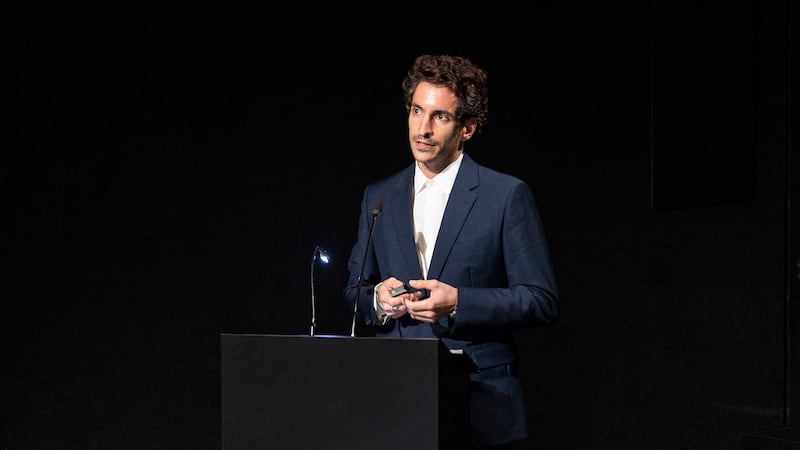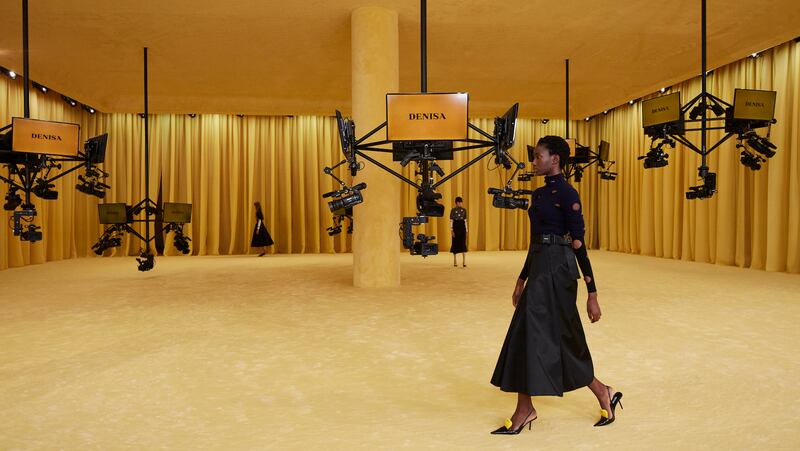
The Business of Fashion
Agenda-setting intelligence, analysis and advice for the global fashion community.

Agenda-setting intelligence, analysis and advice for the global fashion community.

Looking out from the sixth story of Prada’s sprawling art foundation in Milan, chief executive Patrizio Bertelli sees a bright future ahead.
While the pandemic delayed results of a multi-year turnaround, sales have recovered rapidly this year. Now Prada is ready to put the lengthy restructuring behind it and welcome a new phase of growth.
Speaking to The Business of Fashion on the eve of the company’s first investor day in seven years, Bertelli presented ambitious new targets for growth and profitability. It’s a strategy designed to pave the way for the 75 year-old executive to step aside. Bertelli could hand over the reins of the company to his and Miuccia Prada’s son Lorenzo in as few as 3 years.
“Lorenzo has the right attitude,” his father said. “He just needed to get his hands on the business.” The young executive gave his first ever interview to BoF last year.
ADVERTISEMENT
Prada is aiming to grow its sales to €4.5 billion ($5.1 billion) in the mid-term, leaning on ramped up investments in communication, a renewed focus on young consumers, and buzz from a star co-creative director, Raf Simons, to deliver growth of 12 to 15 percent per year.
It’s also planning for the long-term. In addition to preparing for succession, the company has earmarked a substantial budget for initiatives that include acquisitions to reinforce its supply chain and accelerate progress on sustainability, as well as upgrading its technology infrastructure.
Lorenzo Bertelli joined Prada in 2018 to run a digital communications push, part of the company’s race to catch up with rivals on social media and e-commerce. It was also a way to start grooming the executive to take over. At the time, his father told reporters the younger Bertelli would be allowed to take the reins of the company one day “if he wants to.”

On Thursday, the two men equivocated on the timing for any leadership transition. “Whether it’s two, three or five years doesn’t matter, most important is that you plan it in time,” Lorenzo Bertelli said. " His father quipped that “in three years, statistically there’s only a ten percent chance I’ll be alive, so it’s normal to think about these things.” (He was exaggerating: the average life expectancy in Italy is 81 years.) The news was first reported by Bloomberg.
Lorenzo Bertelli’s increased influence already seems to be accelerating the pace of new initiatives. He said the group plans to expand in luxury jewellery, including a major launch next year. It is exploring gaining the B-Corp sustainability certification, and examining opportunities for marketing in the buzzy (and vague) “metaverse,” he said.
“We have a second line in the company that’s really pushing,” Patrizio Bertelli told BoF.
On the creative side, Bertelli said that the brand’s 72 year old co-CEO and co-creative director, Miuccia Prada would “continue to work for as long as she wants.” While Simons’ addition to the brand’s creative helm last year led to speculation the star designer might be preparing to step back, the relationship between the pair “is strengthening day in and day out in a very natural way.”
While a clearer view on succession and rapidly improving numbers make Prada a less vulnerable target for a takeover, Bertelli also struck a more open-minded tone regarding potential deal-making in the company’s future, saying remaining independent was “not the first objective.”
ADVERTISEMENT
Retail sales for the third quarter rose 18 percent over 2019′s pre-pandemic levels, the company said, accelerating from an 8 percent two-year growth rate in the first half.
“We will certainly close this year better than in 2019,” Bertelli said. The acceleration in the second half of 2021 “sheds light on what we can expect for 2022.”
But Prada still lags luxury peers like LVMH and Hermès, who have surged out of the pandemic slump with growth rates up to 40 percent, pointing to fierce competition still ahead. It remains to be seen if the company can buck the trend of big groups taking market share from independent players in the long term.
Prada’s turnaround has been a lengthy journey. After a slowdown in China’s economy and a state crackdown on corruption sent sales tumbling by 10 percent in 2016, the brand struggled to rebound even as growth came roaring back for big luxury conglomerates like Gucci and Balenciaga-owner Kering or Louis Vuitton parent LVMH.
Sales started to pick back up in 2018 after the company reintroduced its nylon accessories and Linea Rosa sub-brand (which it had mostly abandoned in favor of more high-end leather goods), bringing back the iconic lines at higher price points than before. Prada shifted its merchandising focus from minimalist workwear staples to more directional, street-savvy pieces, and the digital marketing push overseen by Lorenzo Bertelli started to see results.
“Maybe we had been following our mature customers a bit too much,” Patrizio Bertelli said. “We’re selling a lot more to younger generations now.”

To be sure, the pandemic dampened the brand’s turnaround, as Prada’s sales tumbled 24 percent (in line with the broader luxury market) from €3.2 billion to €2.4 billion last year. But that pressure eased swiftly. By the second half of 2020, retail sales were down just 6 percent from a year earlier, sparking renewed confidence in the company’s underlying appeal. Shares have nearly doubled since the company’s trading update last July.
Bertelli forged ahead with plans to eliminate all markdowns in Prada’s mainline stores and reduce its exposure to discount-prone wholesalers and e-tailers.
ADVERTISEMENT
Designer Raf Simons joined the company as co-creative director alongside Mrs. Prada in March last year — just as the coronavirus pandemic was exploding across Italy, which found itself in four months of strict lockdown.
The brand’s first shows with Simons bucked the trend of mostly-forgettable online-only fashion weeks during the pandemic: his debut collection, captured by a panopticon of dozens of robotic cameras, captivated fashion audiences who were eagerly waiting to see what the two star designers would come up with, whether an audience was present or not.
In recent months, e-commerce sales have continued to accelerate even as stores reopened after coronavirus shutdowns. In the third quarter of this year they were five times higher than in 2019 (up 400 percent year-on-year). The company expects them to account for 15 percent of sales mid-term.
Continuing to ratchet up digital will be a big part of Prada’s future growth, Bertelli said. The brand has increased its budget for online communications by 80 percent since 2019, and plans to invest another €150 million over the next three years to upgrade its tech infrastructure.
The brand hopes that its tech upgrade, “judicious” price increases, bigger and better marketing, and continued buzz under its star co-creative directors will boost retail productivity by 30 to 40 percent mid-term. That would allow the company to hit its targets for rapid growth without the expensive task of expanding its store footprint.
The younger Bertelli is also leading efforts to boost Prada’s sustainability credentials, an increasingly important issue for young luxury consumers. The brand set targets that would tackle carbon emissions throughout its supply chain for the first time this year, in line with efforts at many peers.

Prada is also investing heavily in its supply chain, an area where most Italian luxury brands have lagged behind French labels like Chanel and Hermès. Prada inaugurated a 350,000 square foot manufacturing headquarters in Tuscany in 2019 and spent more than €80 million on supply chain acquisitions and investments over the past two years. It’s earmarked another €70 million for 2022. Those investments will make it easier to accelerate progress on sustainability and secure the brand’s access to skilled craftsmanship at a time when many operators of luxury suppliers are reaching retirement age.
“Who’s going to manufacture our products for the next 20 years’ time? We need to equip,” the older Bertelli said.
As for the company’s own future in a rapidly consolidating market, Bertelli has frequently maintained that he and Mrs. Prada have no interest in selling their 81 percent controlling stake in the brand.
And opportunities to consolidate are few. The executive is more interested in acquiring factories than other brands, he says, while larger rivals like Chanel and Cartier-owner Richemont are “focused on organic growth,” he said. In Italy, it’s “too late” for a luxury group to emerge.
Patrizio Bertelli isn’t intransigent in his position toward future consolidation, however. Remaining independent “is not the first objective we would have in mind,” he told BoF Wednesday. “Eventually you can own a smaller slice of a bigger cake.”
Asked about a reported meeting with Kering’s chairman François-Henri Pinault in late 2019, Bertelli was coy. “It’s normal to meet people working in the same industry as you… It’s not that every time you meet it means you’re going to merge,” he said.
Editor’s Note: This article was updated on 18th November 2021. The updates added information from the company’s investor day and corrected an inaccurate caption for the image of Prada’s Spring 2022 show.
Related Articles:
The LVMH-linked firm is betting its $545 million stake in the Italian shoemaker will yield the double-digit returns private equity typically seeks.
The Coach owner’s results will provide another opportunity to stick up for its acquisition of rival Capri. And the Met Gala will do its best to ignore the TikTok ban and labour strife at Conde Nast.
The former CFDA president sat down with BoF founder and editor-in-chief Imran Amed to discuss his remarkable life and career and how big business has changed the fashion industry.
Luxury brands need a broader pricing architecture that delivers meaningful value for all customers, writes Imran Amed.